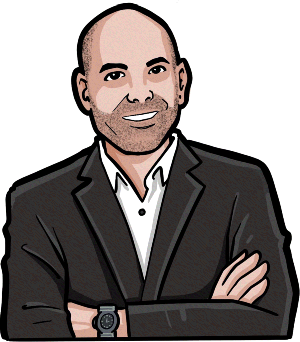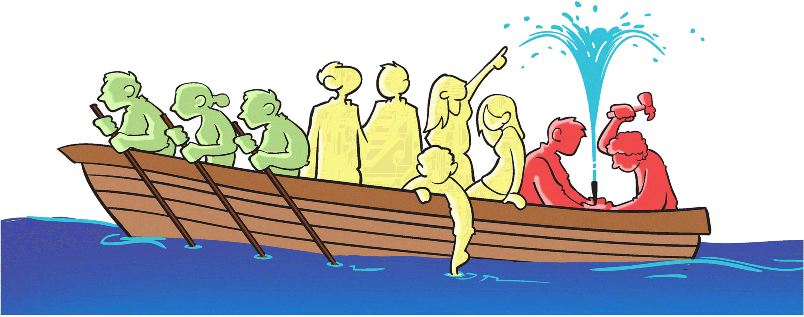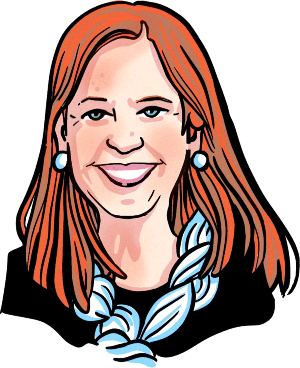Chapter 15
The MeTEOR Story: Extreme Ownership
Extreme Ownership by Jocko Willink and Leif Babin has become one of the biggest business books of the past decade.1 And for good reason; it brought a kick-butt, scream-in-your-face, knife-between-the-teeth intensity to the issue of personal responsibility and owning everything—mistakes, successes, failures, improvement.
The authors, retired Navy SEAL officers, know that failure to own it is a failure to lead. Pure and simple. The only way to succeed is to accept responsibility for everything and blame no one and nothing, not even in your most private 3 a.m. thoughts. Own it, dammit, or sell the farm, move to town, and get a job bagging groceries.
When I read the book, I immediately saw MeTEOR Education, a consulting organization in Gainesville, Florida. But I knew MeTEOR when it was Contrax, a school furniture supplier. Even in those days, the owners—Bill Latham and John Crawford—had a much larger dream, an extreme dream: they wanted to transform education in America. Not Gainesville, not Florida, but the whole country. That's pretty extreme. After reading my book, Change Your Space, Change Your Culture,2 they thought I was just the guy to help them do that. I listened to their proposition and, after a two-hour lunch, essentially told them I didn't know anything about education: “Look, I'm not your guy.”
But Bill and John were like characters in a 1940s film comedy: when I would walk out my bedroom door in the morning, they would be standing there and immediately start talking at the point they were making last night when I shut the door in their face. They didn't know how to be discouraged.
In the end, they did such a good job at marshaling leaders and funding that I had to take the project. Bill and John made an incredible team: laser-focused, forceful, and unrelenting. I nicknamed them the Blues Brothers; they were on a mission from God.
Contrax's success was built on an intense sales culture and wraparound customer service. Their compensation structure rewarded closing deals and moving quickly to the next. They reminded me of the old story of the extreme bear hunters.
The first guy leaves the cabin and disappears into the hills. Eventually, he sees a bear asleep in his cave. The guy goes in and kicks the bear till it wakes up, really angry. As the bear starts to give chase, the guy runs back towards the cabin.
Running down the hill, he screams, “Open the door! Open the door!”
His partner opens the door just in time for the guy to run into the cabin. The angry bear follows close behind and soon fills the cabin with his roaring presence.
The first guy jumps outside and slams the door. As he takes off for the hills, he shouts back, “You skin that one. I'll go get another.”
John and Bill were those guys. They were unorthodox, but they built a highly successful, close-knit, work-hard, play-hard organization.
To Own Change
Halfway through that education project, John and Bill realized they had launched a journey of no return. To have the impact they wanted, Contrax would have to morph from a company that sold and serviced classroom furniture into an education and consulting organization. They had to show communities, school districts, principals, and teachers how to transform their schools. John and Bill began deliberately working to build the kind of culture they would need to support the company they were going to become.
And they did it. Contrax did become MeTEOR Education. They created a new business mission and strategy, and rebranded and restructured from a centralized support hub to regional studios. But, then, when that rapid growth and increased complexity revealed cracks in the foundation, they invited me to help them.
I started by asking what kind of new work they would be doing? How would that work flow through the organization? What roles would they need to add? What kinds of skills? Would that require new people? Or could they teach old dogs new tricks? That conversation led to the more critical second conversation.
We shifted the focus to Contrax's current culture. I asked: “What is the current shadow culture? Help me understand the habits and behaviors that really run the place and have made Contrax a success.”
Leaders and managers seldom see, let alone touch, the true shadow culture. Shadow cultures are like wolves in the wild. You rarely see one during daylight. I never fault leaders or managers for not having a grasp on shadow culture. However, without seeing and understanding that hidden side of the company, they'll never be able to shape, guide, and align it with the aspirational side of the company.
Then I took them through an exercise based on the television show Hell's Kitchen. We talked about the two sides of Chef Ramsay. The dining room Chef Ramsay is gracious and all smiles. But the kitchen Chef Ramsay throws sharp objects, curses, shows favoritism, and stand inches in front of faces and calls people “dirtbags.” That is the differences between the publicized culture of an organization and its shadow side.
When I left, I gave them an assignment, an exercise at looking for the gaps. I asked them to keep a journal for the next month. “Observe and capture two kinds of behaviors. First, those spontaneous behaviors that impress and make you feel proud. Second, those that make you shake your head and wonder, ‘What were they thinking?’”3
At the end of that month, the team gathered in a conference room and shared stories. Many stories evoked that knowing familiarity with what everyone knew. Naturally, some stories were extremely funny; some were sobering and emotional. But the act of sharing stories gave everyone a textured portrait of the company. The process revealed very constructive patterns and insights.
Next, each participant selected the top five positive and negative examples, and wrote brief descriptions on sticky notes. We put all the sticky notes on the conference room wall. The notes were then sorted into five positive and negative categories. That pulled everyone out of their chairs and into engaged conversation around moving the notes back and forth until categories took final shape. Once the categories were created, each column became a theme.
When we stepped back and looked at the wall, the collage became a portrait. Everyone saw five explicit themes, values, traits, and stories. The group also saw how the attributes added or drained value. Then the team reflected on where those behaviors came from and how the current culture reinforced them. Everyone stepped back and looked in the mirror.
“We Are a Numbers Culture”
The exercise included the critical questions about shadow culture.
- What messages do we, as leaders, send?
- What behaviors do we formally and informally reward or punish?
- Who feels entitled? Why?
- Who feels like they are second-class citizens around here? Why?
- What behaviors do we tolerate, and why?
- How does our environment reinforce the attitudes and behaviors we want to change?
As we gazed at the questions, I asked the team, “What do you value? And Bill spoke first, “I guess we value numbers. You get rewarded for numbers, and you get spanked for numbers.”
That was a moving moment. I said, “No judgment here, Bill. Numbers are very significant. But, the real question is, do you want this to be a value or a by-product? If you want it to be a value, then you can begin to align your organization around the behaviors you want and the collateral costs you will incur.”

Bill looked around the table, “That is not who we want to be.”
That moment impacted everyone in the room, including me. I've facilitated many of those meetings; I typically hear a positive spin or a rally speech. That, however, was a rare moment of acknowledging a hard truth, but it also brought clarity and freedom. Everyone in the room needed to hear Bill take ownership and resolve to change.
That moment revealed Bill's extreme leadership. He owned everything; he blamed no one. And he did it out of a passion to take care of his people. Everything about Bill hovered around treating people with dignity and respect. He wanted to build a successful business, yes. But, like the very best owners and CEOs, he saw that business as part of the vast biosphere that nurtured those who showed up at his place every day.
Boat Behaviors
Over the years I've learned that if there are 10 employees in a boat, three will be happy, intent, eagerly rowing, and in sync. Gallup calls those employees the engaged. Five in the middle will be happy. The two in the back of the boat will be drilling a hole through the bottom of the boat. This is the norm.
The five in the middle are happy because they are along for the ride. They will do a good job if you tell them what to do and how to do it, troubleshoot when they get stuck, and follow up to make sure they did it. I call them “the managed.” They are the ones who eat up the day for managers; they are the reason managers feel stuck, powerless, and ineffective. This is also the group that derives the most from a well-designed culture. They are usually good people who follow. A well-designed culture answers most of their questions, the ones they currently take to management:
- What is expected of me?
- How do we get things done around here?
- How do we treat one another?
- Who do I go to if I get stuck?
- What does success look like?

Figure 15.2 Ten employees in a boat will all feel differently about the ride.
A poorly defined culture, culture by default, also comes up with answers to those questions, answers that take the form of workarounds, politics, turf protection, informal alliances, whispers, insiders, outsiders, and referees (managers). Poorly defined culture is incredibly wasteful. It not only wastes most of a manager's day, but it also slows and impedes actual work.
Using culture to nudge the middle of the boat riders toward the front is the most effective and the most sustainable lever. It is the difference between farming in rich topsoil or using fertilizers and chemicals to force the soil to produce.
Once that middle group shifts forward, it becomes much easier to deal with the toxic 20% in the back of the boat. They have no place to hide. Often, they see how out of step they have become and just choose to move on.
What Did We See, What Did We Learn?
Through our work together, MeTEOR identified some natural behaviors, strengths, that shined when they were at their best:
- Going the extra mile
- Giving people a voice
- Constantly learning and getting better
- Looking to continually innovative
- We travel in one boat
Bill and his team began to see that those descriptions formed guiding values for MeTEOR. They recognized that “we are in one boat together. We must become a company of we, not me.” Suddenly, everyone could clearly see what those values looked like. They saw people who consistently modeled the values.
They also identified and called out the behaviors that had the largest adverse effect on the company. The examples helped to explain why. Leadership also explained how the compensation system, the way of keeping score, and overlooking bad behavior produced the harmful effects.
MeTEOR saw how people respond when the values of the company are simple, clear, and healthy—not just in posters, but throughout the company culture. There was nothing to fabricate in order to appear as something they were not. As Bill pointed out, “We can now work on becoming a better version of who we are.” In the past, the MeTEOR culture existed by default. Today, it permeates by design. It is clear, tangible, natural, and extreme. Those in the middle of the boat have naturally begun to shift to the front. Culture now provides the answers to the five guiding questions. Managers can now plan and coach more.
Pressing into Well-Being
After partnering with us on our Humanizing Education MindShift, Bill and his team also joined us in our work on health and well-being. Chelsea Poulin, MeTEOR's new director of well-being, represented the company in our MindShift. I could see that Chelsea had been taught by Bill; she too is extreme in her pursuit of excellence and care. Our summits and our community helped Chelsea to see how many and very diverse companies approached wellness. As a result, Chelsea went back to MeTEOR and helped move them toward a culture of health.
Chelsea also invited Mim Senft to consult with them on the broad dynamics of change. Seeing MeTEOR through Mim's eyes confirmed what I saw and knew of Bill's leadership. That was especially helpful as MeTEOR built a new culture of health.
Mim saw the company change through a major leadership commitment to wellness. She clearly saw that “Bill Latham is a leader that cares. Naturally, he wants to see his company succeed, but he also cares about creating thriving teams.

“The MeTEOR team's goal was clear: ‘We want to make sure that what we do is effective and leads to better lives for those on the team.’ They believed that had to be a behavioral change, not simply throwing some dollars or checking a box that they are supporting wellness.
Mim helped the company adjust to a new platform of health and well-being: “When we talked about the basics, benefits, pay, diversity, and demographics, that's where change really started. Bill was even fully supportive of employees' right to unfettered access and conversation with me. If they had a complaint, they were free to divulge it to me. Through all that, I saw that one of the core values at MeTEOR is the use of Co-Creative Voice. They believe it is the right and responsibility of their employees to use their voice in shaping the future.
“We've had deep conversations about paid time off (PTO). I pushed MeTEOR about creating a culture where people can take real vacations. Wellness also means that employees are encouraged to take time with their family, or friends in a personal retreat. They need to know they can go and totally recharge, knowing their team is strong enough to handle the work when they are out. And I emphasized that it starts with leadership giving the permission by example.
“So, Bill took his wife of 22 years to Scotland. He had not taken a personal vacation in the 17 years of leading Contrax and MeTEOR. But, to my surprise, he did not even take his phone or computer. His final instruction to his team was they were to only contact him if there was a “school furniture emergency.” And then he reminded them there is no such thing as a school furniture emergency. That is what leadership does: set the example and create the tone. They demonstrate trust in everyone to take care of business. Most leaders simply don't trust their own companies. And it leads them to a belief that the place will burn down if they aren't there. That kind of attitude waterfalls down throughout the organization.
“MeTEOR is now fully committed to the quantity and the quality of the time their employees need to take to recover and renew. But they are going even further than PTO. They are exploring ways for their people to take deeply discounted vacations with their families. That's a great message for the employees: We're going to give you the opportunity to take less expensive vacations around the world.
“They are also getting a handle on e-mail. When we talk about people having a day of rest, what does that really mean? Does it mean you're resting, recovering, and taking time with family and friends? Or, are you answering work e-mails? So, MeTEOR now nudges employees away from company e-mails for the weekend!”
Extreme Ownership: “What Gets Done”
Over the past two decades, MeTEOR has developed a culture of getting things done. It is built on a fanatical adherence to seven habits Bill and John developed over the past decade. Bill jokingly jabs, “Let's not talk about your idea unless we plan to do something about it.” I've picked up their habits and they have helped me with several clients break the meeting trap of what I call “deciding to decide” but in the end not doing anything. The language of MeTEOR's “Habits of What Gets Done” produces clarity, alignment, and commitment and should permeate every company meeting.
- What gets PICTURED gets done.
- Leader Question: How consistently am I doing this?
- Idea: People forget the vision within four weeks, so paint the picture constantly.
- Action: Find ways to continuously reinforce the vision. Print it. Hang it on the wall. Sing it. Make movies about it. Slap it on the side of city busses. Use it to kick off meetings. And then close meetings with it.
- What gets MODELED gets done.
- Leader Question: What kind of example am I setting?
- Idea: People determine what is important by what their leaders do.
- Action: Model action. Don't talk. Act. Let action draw attention, generate conversation, and provide context.
- What gets PRAISED gets done.
- Leader Question: Do I acknowledge and thank others? Consistently and sufficiently? Is it systemized throughout our workplace?
- Idea: Reinforced and honored behavior is repeated behavior.
- Action: Celebrate successes in visible ways. If your team has a good existing system for recognizing success, use it. If you don't or if that system has grown sterile, create a new one. Give credit to others consistently and publicly.
- What gets TRAINED gets done.
- Leader Question: Is this on the calendar and is it meaningful?
- Idea: A person performs up to the level of training.
- Action: New skills require new experience. Evaluate the awareness, knowledge, and readiness of your organization to take on new responsibilities. Look for people in your organization who have interest and skill in teaching. Place personal growth and leadership skills at the top of your priorities.
- What gets MEASURED gets done.
- Leader Question: Do we measure the quantity and quality of our work?
- Idea: Measurable goals get done.
- Action: All goals need time-bound metrics. Identify ways to quantify your effort: participation rates, projects initiated, satisfaction scores, sick days, revenue, profit, results. Metrics incentivize team performance and allow you to determine the scope of your impact.
- What gets FINANCED gets done.
- Leader Question: Am I pretending some of my initiatives will get done without resources?
- Idea: Budgets must reflect our plan and priorities.
- Action: Strategic initiatives demand resources—time, people, capital, etc. If your initiative doesn't have dedicated resources, it's time to identify what you need and begin asking for it. Leverage your coalition to secure funding. Consider starting with a prototype and scaling accordingly.
- What gets SCHEDULED gets done.
- Leader Question: Are my most important activities on the calendar? Do I respect that time?
- Idea: If it is not on the calendar we are not committed to it.
- Action: Create an action plan and schedule accordingly. Use the Priority Matrix to focus calendar time on important priorities and weed out distractions. Set target dates for key deliverables and clearly communicate progress.
Hope, axioms, confidence, and theory only go so far. At some point, everyone needs a model of what they believe or assume. MeTEOR Education is one company that models care for employees and community. Bill's personal example of living out his convictions about responsibility makes him a lighthouse on a rocky coast.
